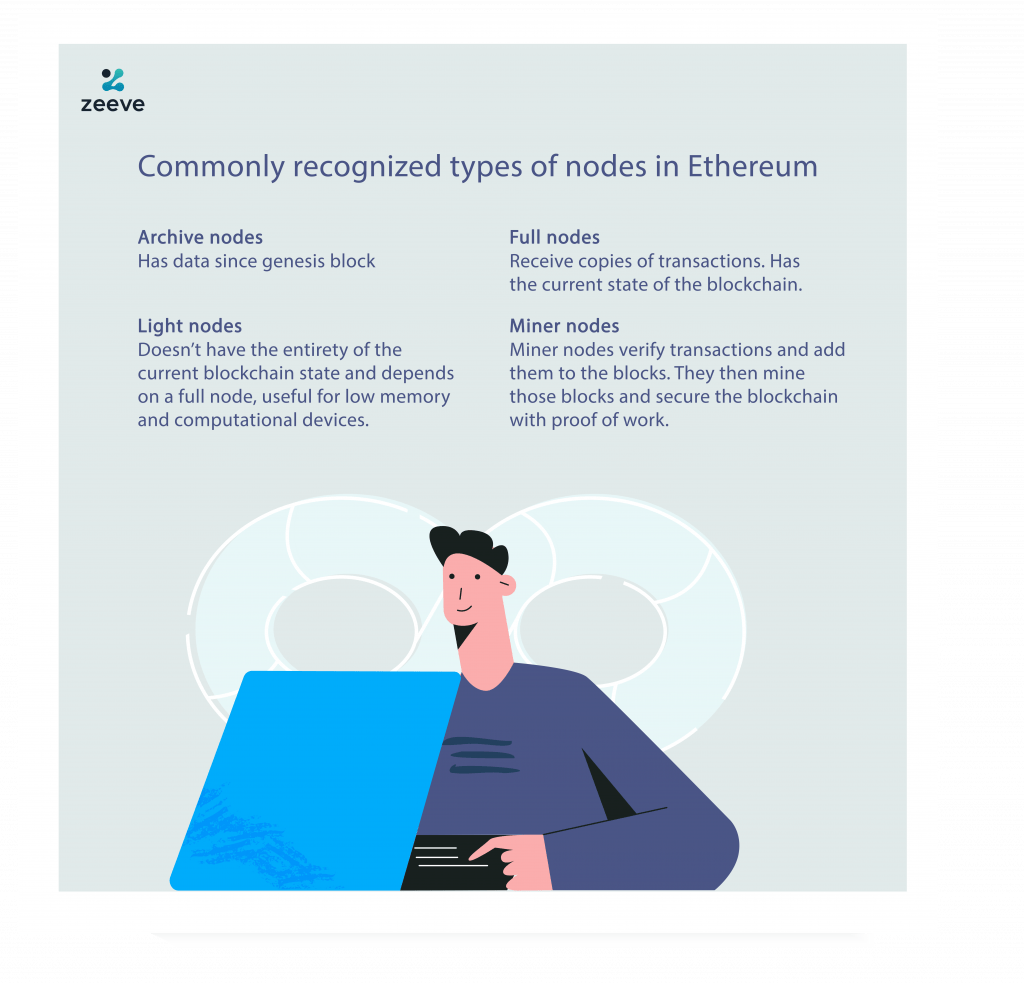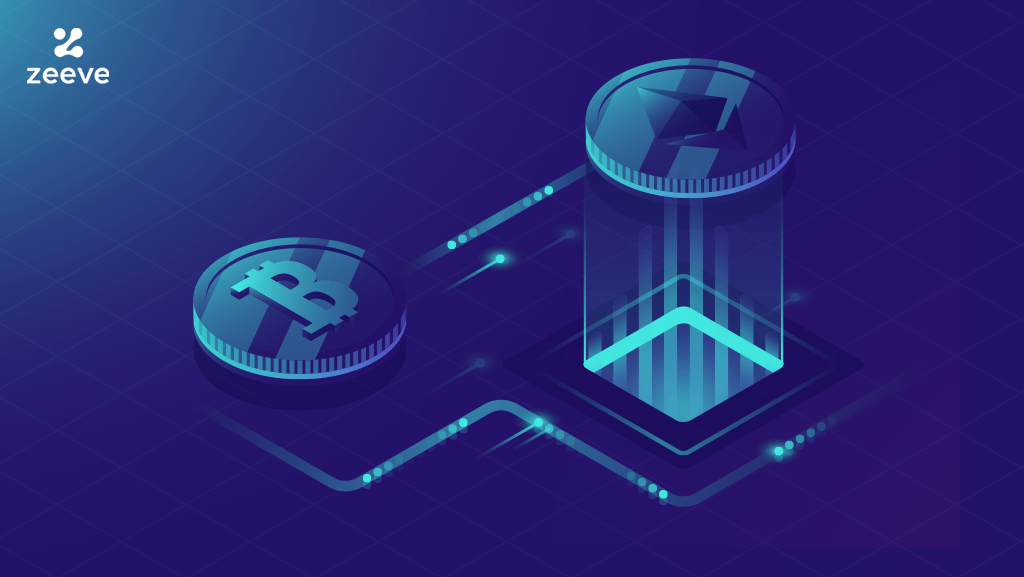Termed the backbone of the crypto ecosystem, Ethereum is a decentralized network of nodes interlinked to each other with a native currency Ether (ETH). Every day, Ethereum nodes process a million transactions, which suggests the inherent strength of the ecosystem. The blockchain lies at the core foundation of DeFi world with a large community to back the projects based on Ethereum. This explains a bit why there are so many projects coming up on Ethereum.
All transactions on Ethereum are the outcome of the carefully laid network of nodes that govern their operation and provide for seamless data transfer. These nodes receive inputs, execute some kind of operations on them, and generate an output. Functioning of the node is carried out in line with conditions called parameters.
Before diving into ‘How to deploy Ethereum blockchain node’ FAQs, let us understand what Ethereum clients and nodes are, and what it means by running a node.
Ethereum clients and nodes
Usually, the term ‘client’ refers to software needed to interact with the service rolled out by the server. For instance, the email service you have been using is a software client that converses with an email server and enables you to decrypt and read the mails received.
An Ethereum client points out to the software that enables the nodes to read blocks and smart contracts on the blockchains. A node, on the other hand, is the operating piece of the client software. To run an Ethereum node, the first step is to download a client application of the blockchain. ‘How to run an Ethereum node’ is generally one of the first FAQs on Ethereum blockchain.

Understanding Ethereum nodes
The term ‘node’ refers to a machine that runs Ethereum client software to perform a certain function. There are three types of nodes – full, light, and archive – and what you choose depends on your specific requirements. Each node interprets data in a unique way, using diverse methods for synchronization, which has a bearing on how quickly the node is able to retrieve updated information.
Let us have a quick glance at the functioning of the three nodes –
Full nodes – They can store and distribute data from the complete blockchain. Additionally, a full node undertakes block validation as well.
An advantage of deploying a full node is that it can conduct direct interaction with an Ethereum-based smart contract. Full nodes can also implement smart contracts directly into the public blockchain. The downside is that full nodes will have a toll on your machine’s hardware and bandwidth resources.
Light nodes – They store only header chain information such as the hash of the previous block and the timestamp. For additional information, they need to make a request. Going data light, they turn out to be quite useful for devices like smartphones. They make only partial participation in block validation.
Archive nodes – They retain an archive of historical blockchain states even after a client is done with synchronization. This is unlike the full and light nodes that prune the historical data. These nodes are quite useful in the application of chain analytics and block explorers.
What it means by running a node
Client software downloads a copy of the blockchain. Validity of every block is validated and information about the new blocks is updated. To simplify, to create a node is the act of continuously operating client software on an Internet-enabled machine. For optimizing performance and minimizing node downtime, most users prefer running their nodes on the cloud to take advantage of the full infrastructural support. Advantages of the cloud include better collaboration among developers, excellent accessibility, low maintenance cost, services in the pay-per-use model, flexible storage, and closely monitored data security, among others.
How to deploy a node on Ethereum
Client implementations
You need a client application on your computer to implement a node. Moreover, to start with, you need to select the client, the environment, and the parameters.
Regarding client implementations FAQs, you need to set in motion different sync modes and a range of other options. Sync modes refer to various methods of validating data on the blockchain. You have to decide on key parameters like disk space and sync time. By performing the Ethereum client along with the corresponding flags, you can set up different client configurations. Ethereum has rolled out several testnet works as well for testing objectives.
Environment – local or cloud
Ethereum clients, whether on a local physical machine or a cloud server, can work perfectly well on the usual computers and don’t need any special hardware. Let us glance at how the environment differs in both:
Local
Installation on a local machine reflects a trustless and sovereign approach, requiring one-time investment. You have the option to buy pre configured machines or configure them later. For preparing, maintaining, and potential troubleshooting the machine, you also need to have a capable in-house team.
Cloud
On the cloud, your upkeep charges come down drastically. Moreover, cloud providers ensure high server uptime. You also get static public IP addresses. From a technical point of view, having a dedicated or virtual server is more convenient than building your own.
As for the downsides, you have to trust a third party server provider. Storage size for full node will also expectedly be high, so cost might go up. However, considering the value of advantages that you get, the downsides are negligible.
Hardware
For each client and sync mod, Ethereum documents recommend disk space requirements. In most cases, modest computing power is adequate though you have to be careful about drive speed. SSD helps a lot as Ethereum clients execute plenty of read/write operations during initial sync. On a single board computer with ARM, you can operate most of the clients. It is important to check sync times and requirements for storage. You also need to ensure your Internet connection has unlimited bandwidth.
Operating system
Ethereum clients are compatible with major operating systems – Windows, Linux, MacOS. You can run full nodes on desktop or servers with the OS of your choice, placed on the cloud.
The process
Download an executable application or installation package that is compatible with your OS architecture. Some clients might have repositories leading to easier installation and updates. As all Ethereum clients are open source, you can use a proper compiler to build clients from source code.
Prior to starting the client software, make sure that the environment is prepared. You need to check availability of disk space regarding the chosen network and sync mode. Other programs should not interfere with memory and CPU. The OS should be updated and have the correct time and date. On listening ports, your router and firewall should accept connections.
At the start, operate your client on a testnet to ensure everything is working as expected. To inform about your preferred configuration, use flags or the config file. Client settings that aren’t default have to be declared. Client execution puts into motion the core functions, endpoints, and begins exploring peers before starting synchronization. When the client is in sync with the current state, current blockchain data is available.
Using the client
RPC API endpoints that clients roll out enable you to control the client and communicate with the network in a number of ways. These include manually calling clients with a protocol, attaching a provided console, and performing clients in diverse applications. Various Ethereum clients implement the RPC endpoints in a different way. Standard JSON-RPC is usable with every client. Applications can use this RPC to extract information from the Ethereum network.
Reaching RPC
JSON-RPC carries the default port of 8545 though the ports of local endpoints are modifiable in the config file. To remotely access the RPC, you need to alter the address to 0.0.0.0 and also set up port forwarding. Be careful when doing it though as it might give anyone online control over your node. Access to your RPC interface can also be hosted by pointing the service of web server to the client’s local address and port.
Operating the node
When running an Ethereum node, you need to keep it online for maximum possible time else it will not be in sync with the network. Though you might restart it, if necessary, do keep in mind that
The process might consume some time if the writing of the current state is undergoing.
- The database is likely to suffer if you opt for a forced shut down.
- Your client will need to resync when you restart the machine.
- Going offline, even for a while, will affect all services dependent on the node.
Automated running of client
You may create a service to perform a client automatically on startup. If you are using Linux servers, for instance, you may set up a service which performs the client on proper config. The client will be under user with limited privileges.
Regular updating of client software
For proper functioning, you need to regularly update your client software with the latest security patches, features, and EIPs. In the event of hard forks, in particular, performing the correct client version becomes important.
Developing additional services
Performing an Ethereum node enables you to use services requiring direct access to client RPC. Such services include critical infrastructure such as consensus clients and layer 2 solutions.
Node monitoring
Nodes enable you to collect valuable metrics that provide you with plenty of useful data. You can turn the information into a database that can later be turned into visualizations and charts. As an administrator, you need to keep a vigil on the machine.
Summing up
Though anyone can run an Ethereum node, most prefer doing it on the cloud to ride on infrastructural and troubleshooting support. Running a node refers to client software you download on a machine needed to interact with the chain of blocks. The node is the operating piece of the client software. Nodes are of three types – full, light, and archive – and your choice depends on your specific requirements.
To start with node implementation, you need to select the client, the environment, and the parameters, depending on whether the implementation is on a local machine or the cloud. For each client and sync mod, the documentation lays down disk space requirements. Checking sync times and requirements for storage are important as well. You can run full nodes on desktop or servers with Windows, Linux, or MacOS.
The process involves downloading an executable application or installation package compatible with your OS architecture while making sure other programs aren’t interfering with memory and CPU. RPC API endpoints rolled out by clients allow you to control the client and communicate with the network in several ways. JSON-RPC has the default port of 8545 and the ports of local endpoints are modifiable in the config file.
You also need to ensure your Ethereum client is online for as much time as possible as the client will need to resync every time the machine is started. To create a service to perform a client automatically on startup is an option as well. Regular updating of client software and node monitoring carries the same importance.
About Zeeve
An enterprise-grade Blockchain-as-a-Service platform, Zeeve facilitates development, deployment, and management of blockchain applications. Thanks to our extensive skill set, Zeeve can implement multiple Blockchain protocols over the cloud as well as on your premises. It is not only cost- and time-efficient but also allows you to set up a blockchain network reliably and securely.
Zeeve rolls out a string of DApp services to develop your decentralized apps at a quick pace. Sign up now to set up your first Blockchain application.





















